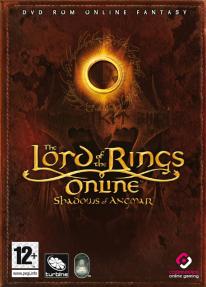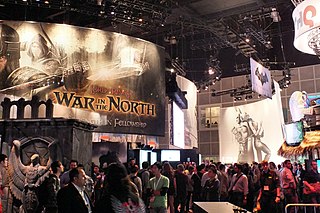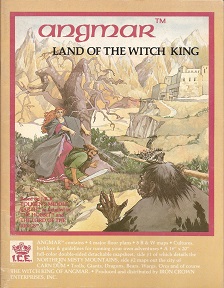The Nazgûl, introduced as Black Riders and also called Ringwraiths, Dark Riders, the Nine Riders, or simply the Nine, are fictional characters in J. R. R. Tolkien's Middle-earth. They were nine Men who had succumbed to Sauron's power through wearing Rings of Power, which gave them immortality but reduced them to invisible wraiths, servants bound to the power of the One Ring and completely under Sauron's control.
Glorfindel is a fictional character in J. R. R. Tolkien's Middle-earth legendarium. He is a member of the Noldor, one of the three groups of the Calaquendi or High Elves. The character and his name, which means "blond" or "golden-haired", were among the first created for what would become part of his Middle-earth legendarium in 1916–17, beginning with the initial draft of The Fall of Gondolin. His name indicates his hair as a mark of his distinction, as the Noldor were generally dark-haired. A character of the same name appears in the first book of The Lord of the Rings, The Fellowship of the Ring, which takes place in Middle-earth's Third Age. Within the story, he is depicted as a powerful Elf-lord who could withstand the Nazgûl, wraith-like servants of Sauron, and holds his own against some of them single-handedly. Glorfindel and a version of the story of the Fall of Gondolin appear in The Silmarillion, posthumously published in 1977.
The Battle of the Pelennor Fields, in J. R. R. Tolkien's novel The Lord of the Rings, was the defence of the city of Minas Tirith by the forces of Gondor and the cavalry of its ally Rohan, against the forces of the Dark Lord Sauron from Mordor and its allies the Haradrim and the Easterlings. It was the largest battle in the War of the Ring. It took place at the end of the Third Age in the Pelennor Fields, the townlands and fields between Minas Tirith and the River Anduin.
Barrow-wights are wraith-like creatures in J. R. R. Tolkien's world of Middle-earth. In The Lord of the Rings, the four hobbits are trapped by a barrow-wight, and are lucky to escape with their lives; but they gain ancient swords of Westernesse for their quest.
Middle-earth Enterprises, formerly known as Tolkien Enterprises, is a subdivision of the Embracer Freemode division of Embracer Group and formerly a trade name for a division of The Saul Zaentz Company. The subdivision owns the worldwide exclusive rights to certain elements of J. R. R. Tolkien's two most famous literary works: The Hobbit and The Lord of the Rings. These elements include the names of characters contained within as well as the names of places, objects and events within them, and certain short phrases and sayings from the works.

The Lord of the Rings: The Third Age is a 2004 role-playing video game developed by EA Redwood Shores for the PlayStation 2, Xbox and GameCube. A turn-based tactics version of the game was developed for the Game Boy Advance by Griptonite Games. The game was published on all platforms by Electronic Arts, and released worldwide in November 2004.

The Lord of the Rings: The Battle for Middle-earth is a 2004 real-time strategy video game developed by EA Los Angeles for Microsoft Windows. The first part of the Middle-earth strategy game, It is based on Peter Jackson's The Lord of the Rings film trilogy, in turn based on J. R. R. Tolkien's original novel. The game uses short video clips from the movies and a number of the voice actors, including the hobbits and wizards. It uses the SAGE engine. The sequel, The Lord of the Rings: The Battle for Middle-earth II, was released on March 2, 2006.

The Lord of the Rings Online is a massively multiplayer online role-playing game (MMORPG) for Microsoft Windows and OS X set in J. R. R. Tolkien's Middle-earth, taking place during the time period of The Lord of the Rings. Originally developed by Turbine, the game launched in North America, Australia, Japan, and Europe in April 2007 as The Lord of the Rings Online: Shadows of Angmar. Players could create characters of four races and seven classes and adventure throughout the region of Eriador. In November 2008, the Mines of Moria expansion was released, adding the region of Moria and two new playable classes. It was followed by the Siege of Mirkwood in December 2009. In 2010 the game underwent a shift from its original subscription-based payment model to being free-to-play.

The Lord of the Rings: The Fellowship of the Ring is a 2002 action-adventure video game developed by WXP for the Xbox. It was ported to the Game Boy Advance by Pocket Studios and the PlayStation 2 and Microsoft Windows by Surreal Software. The game was published by Vivendi Universal Games under their Black Label Games publishing label. In North America, it was released for Xbox and Game Boy Advance in September, and for PlayStation 2 and Windows in October. In Europe, it was released for Xbox, Windows and Game Boy Advance in November, and for PlayStation 2 in December.

The Lord of the Rings: The Battle for Middle-earth II is a 2006 real-time strategy video game developed and published by Electronic Arts. The second part of the Middle-earth strategy game series, it is based on the fantasy novels The Lord of the Rings and The Hobbit by J. R. R. Tolkien and its live-action film series adaptation. It is the sequel to Electronic Arts' 2004 title The Lord of the Rings: The Battle for Middle-earth. Along with the standard edition, a Collector's Edition of the game was released, containing bonus material and a documentary about the game's development.

The Lord of the Rings: War of the Ring is a 2003 real-time strategy game (RTS) developed by Liquid Entertainment and published by Sierra Entertainment, a subsidiary of Vivendi Universal Games. Set in J. R. R. Tolkien’s fictional Middle-earth, it expands upon the events of the War of the Ring as told in his fantasy novel, The Lord of the Rings.

There are many video games that have been inspired by J. R. R. Tolkien's works set in Middle-earth. Titles have been produced by studios such as Electronic Arts, Vivendi Games, Melbourne House, and Warner Bros. Interactive Entertainment.
In J. R. R. Tolkien's Middle-earth writings, the Dúnedain were a race of Men, also known as the Númenóreans or Men of Westernesse. Those who survived the sinking of their island kingdom and came to Middle-earth, led by Elendil and his sons, Isildur and Anárion, settled in Arnor and Gondor.
The Lord of the Nazgûl, also called the Witch-king of Angmar, the Pale King, and the Black Captain, is a fictional character in J. R. R. Tolkien's fantasy novel The Lord of the Rings. He had once been the King of Angmar in the north of Eriador. He is the bearer of a Ring of Power, one of the nine that the dark lord Sauron gave to Men, who become the Nazgûl or Ringwraiths. This gives him great power, but enslaves him to Sauron and makes him invisible. By the end of the Third Age, his name has been forgotten. He stabs the bearer of the One Ring, the Hobbit Frodo Baggins, with a Morgul-knife which would reduce its victim to a wraith. Much later in the narrative, in his final battle, the Lord of the Nazgûl attacks Éowyn with a mace. The Hobbit Merry Brandybuck stabs him with an ancient enchanted Númenórean blade, allowing Éowyn to kill him with her sword.
Aragorn is a fictional character and a protagonist in J. R. R. Tolkien's The Lord of the Rings. Aragorn was a Ranger of the North, first introduced with the name Strider and later revealed to be the heir of Isildur, an ancient King of Arnor and Gondor. Aragorn was a confidant of the wizard Gandalf, and played a part in the quest to destroy the One Ring and defeat the Dark Lord Sauron. As a young man, Aragorn fell in love with the immortal elf Arwen, as told in "The Tale of Aragorn and Arwen". Arwen's father, Elrond Half-elven, forbade them to marry unless Aragorn became King of both Arnor and Gondor.

The Lord of the Rings: War in the North is a 2011 action role-playing hack and slash video game developed by Snowblind Studios and published by Warner Bros. Interactive Entertainment for PlayStation 3, Xbox 360, and Microsoft Windows. An OS X port was developed and published by Feral Interactive in 2013. It is the first video game based on both J. R. R. Tolkien's 1954 high fantasy novel The Lord of the Rings and Peter Jackson's film trilogy adaptation released in 2001, 2002 and 2003. This is because, until 2009, Vivendi Universal Games, in partnership with Tolkien Enterprises, held the rights to make games based on Tolkien's literary works, whilst Electronic Arts held the rights to make games based on the New Line Cinema films. In 2009, WB Games acquired the rights for both intellectual properties.

The Lord of the Rings: The Card Game is a non-collectible customizable card game produced by Fantasy Flight Games. As part of the Living Card Game (LCG) genre, it is a cooperative and strategic card game set in Middle-earth, a fantasy world featured in literary works by J. R. R. Tolkien, including The Hobbit and The Lord of the Rings. Its digital adaptation, titled The Lord of the Rings: Adventure Card Game, is published by Asmodee Digital for cross-platform play on Microsoft Windows, macOS, PlayStation 4, Xbox One and Nintendo Switch, being the "first ever digital LCG".

Angmar: Land of the Witch King is a fantasy role-playing sourcebook published by Iron Crown Enterprises (I.C.E.) in 1982 based on J.R.R. Tolkien's The Lord of the Rings trilogy. The book expands upon Tolkien's few brief mentions of Angmar, an evil kingdom, providing gamemasters with enough material to create a setting in which player characters can experience Angmar.











